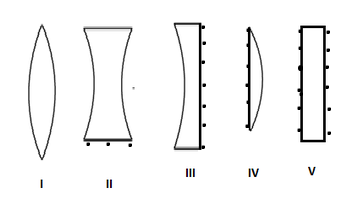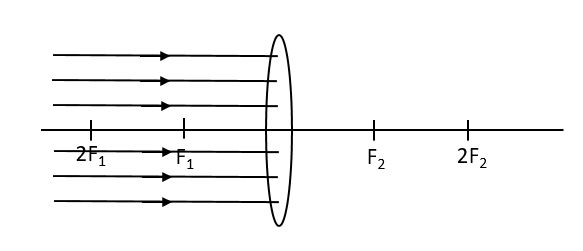10th Grade > Physics
LIGHT - REFLECTION REFRACTION MCQs
Total Questions : 39
| Page 1 of 4 pages
Answer: Option D. -> 2.5 ms−1
:
D
Given:
Initial object distance, u=−60m
Speed of object, vo=20ms−1
Focal length, f=20m
Time interval,t=2s
Applying mirror formula to find the initial position of the image v:
1v+1u=1f
1v+1−60=120
v=15m
Distance travelled by the object is the product of speed and time.
so=vot
so=20×2=40m
Therefore, now the object distance:
uf=u+so=−60+40=−20m
Applying mirror formula to find the final position of the image vf:
1vf+1uf=1f
1vf+1−20=120
vf=10m
Average speed is the ratio of total distance travelled to the total time taken.
Averagespeed of the image:
vi=v−vft
vi=15−102=2.5ms−1
:
D
Given:
Initial object distance, u=−60m
Speed of object, vo=20ms−1
Focal length, f=20m
Time interval,t=2s
Applying mirror formula to find the initial position of the image v:
1v+1u=1f
1v+1−60=120
v=15m
Distance travelled by the object is the product of speed and time.
so=vot
so=20×2=40m
Therefore, now the object distance:
uf=u+so=−60+40=−20m
Applying mirror formula to find the final position of the image vf:
1vf+1uf=1f
1vf+1−20=120
vf=10m
Average speed is the ratio of total distance travelled to the total time taken.
Averagespeed of the image:
vi=v−vft
vi=15−102=2.5ms−1
Answer: Option B. -> Optical density is highest for medium 2.
:
B
Angle of incidence i is same for all three media. Angle of refraction for the different media are:
rm1=45∘
rm2=30∘
rm3=60∘
Deviation will be highest for medium with highest optical density. Clearly, the deviation is highest (30∘) for Medium 2. Hence, Medium 2 has highest optical density.
:
B
Angle of incidence i is same for all three media. Angle of refraction for the different media are:
rm1=45∘
rm2=30∘
rm3=60∘
Deviation will be highest for medium with highest optical density. Clearly, the deviation is highest (30∘) for Medium 2. Hence, Medium 2 has highest optical density.
Answer: Option A. -> nair Sinθair = nwater Sinθwater
:
A
According to Snell's law, for a light ray travelling from one medium to another, the ratio of sines of angle of incidence to the angle of refraction is a constant. This constant is the refractive index of medium 2 with respect to medium one.
Here,
nair sinθair =nwatersinθwater or ⇒SinθairSinθwater=nwaternaircorrectly represents Snell's law.
:
A
According to Snell's law, for a light ray travelling from one medium to another, the ratio of sines of angle of incidence to the angle of refraction is a constant. This constant is the refractive index of medium 2 with respect to medium one.
Here,
nair sinθair =nwatersinθwater or ⇒SinθairSinθwater=nwaternaircorrectly represents Snell's law.
Answer: Option C. -> I, II, III, IV
:
C
Lens should have at least one curved surface, so that it can converge or divergethe incoming light rays. The first optical system is called convex lens and the second one is concave lens. The thirdlens is called a plano-concave lens and the fourth one is called a plano-convex lens.The fifth optical system has two plane surfaces, and hence it can't be considered as lens.
:
C
Lens should have at least one curved surface, so that it can converge or divergethe incoming light rays. The first optical system is called convex lens and the second one is concave lens. The thirdlens is called a plano-concave lens and the fourth one is called a plano-convex lens.The fifth optical system has two plane surfaces, and hence it can't be considered as lens.
Answer: Option D. -> both as a particle or a wave depending on the situation
:
D
Light has dual nature characteristics. It can behave as a particle or a wave depending on the situation. It behaves as a particle in photoelectric effect and as a wave in diffraction.
:
D
Light has dual nature characteristics. It can behave as a particle or a wave depending on the situation. It behaves as a particle in photoelectric effect and as a wave in diffraction.
Answer: Option A. -> True
:
A
The speed of light rayswhile entering a denser medium from a rarer medium decreases and to reach at the destination in the shortest time (Fermat's principle), it bends towards the normal.
:
A
The speed of light rayswhile entering a denser medium from a rarer medium decreases and to reach at the destination in the shortest time (Fermat's principle), it bends towards the normal.
Answer: Option C. -> f1f2f1+f2
:
C
The power of a lens is defined as the reciprocal of its focal length (in metres). When there is a combination of two lenses in contact, the effective power of the combination is the sum of the individual powers.
Total Power, P=P1 + P2
1f=1f1+1f2
f=f1f2f1+f2
:
C
The power of a lens is defined as the reciprocal of its focal length (in metres). When there is a combination of two lenses in contact, the effective power of the combination is the sum of the individual powers.
Total Power, P=P1 + P2
1f=1f1+1f2
f=f1f2f1+f2
Answer: Option B. -> 21
:
B
Herenumber of images formed during each occassionis noted and added
Number of images formed = n =(360∘θ−1)
Total number of images =Number of images when angle between mirrors is at 30°, 60°, 90°and 120°
n = (360∘30∘−1)+ (360∘60∘−1)+ (360∘90∘−1)+ (360∘120∘−1)
n = 11 + 5 + 3 + 2 = 21
:
B
Herenumber of images formed during each occassionis noted and added
Number of images formed = n =(360∘θ−1)
Total number of images =Number of images when angle between mirrors is at 30°, 60°, 90°and 120°
n = (360∘30∘−1)+ (360∘60∘−1)+ (360∘90∘−1)+ (360∘120∘−1)
n = 11 + 5 + 3 + 2 = 21
Answer: Option C. -> Concave lens, f=−2 m
:
C
Let u be the object distance,v be the image distance,
and f be the focal length.
Given:
As per sign conventions,u=−2m
Magnification m=12 (Since size of image is half of that of object)
Magnification in lenses m=vu
12=vu
We get v=u2
⇒v=−22=−1m
Using lens formula ,
1v−1u=1f
1−1−1−2=1f
12−1=1f
f=−2m
Here negative sign indicates that the lens is a concave lens.
:
C
Let u be the object distance,v be the image distance,
and f be the focal length.
Given:
As per sign conventions,u=−2m
Magnification m=12 (Since size of image is half of that of object)
Magnification in lenses m=vu
12=vu
We get v=u2
⇒v=−22=−1m
Using lens formula ,
1v−1u=1f
1−1−1−2=1f
12−1=1f
f=−2m
Here negative sign indicates that the lens is a concave lens.




















